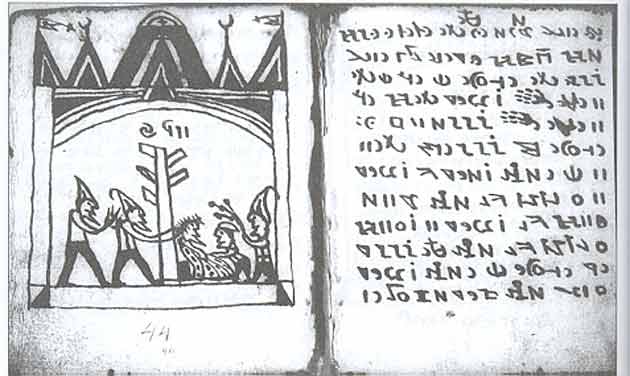
|
|||
The Mystery of Indecipherable Rohonc Codex - Unexplained Mysteries
See more at: http://en.wikipedia.org/wiki/Rohonc_Codex
The Rohonc Codex is an illustrated manuscript book by an unknown author, with a text an unknown language and writing system, that surfaced in Hungary in the early 19th century. The book's origin and the meaning of the text and illustrations have been investigated by many scholars and amateurs, with no definitive conclusion - although many Hungarian scholars believe that it is an 18th-century hoax. The name of the codex is often spelled Rohonczi, according to the old Hungarian orthography that was reformed in the first half of the 19th century. This spelling has spread probably due to the book of V. Enachiuc. Today the name of the codex is written in Hungarian as Rohonci-kodex. The codex was named after the city of Rohonc, in Western Hungary (now Rechnitz, Austria), where it was kept until 1838, when it was donated to the Hungarian Academy of Sciences by Gusztav Batthyany, a Hungarian count, together with his entire library. The origin of the codex is unknown. Since its existence became widely known, the codex has been studied by many scholars and amateurs, but none has succeeded in providing a widely accepted convincing translation or interpretation of the text. It was studied by the Hungarian scholar Ferenc Toldy around 1840, and later by Pal Hunfalvy and by the Austrian paleography expert Albert Mahl. In 1885 the codex was sent to Bernhard Julg, a professor at Innsbruck University. Mihaly Munkacsy, the celebrated Hungarian painter, took the codex with him to Paris in the years 1890-1892 to study it. In 1866, Hungarian historian Karoly Szabo (1824-1890) proposed that the codex was a hoax by Samuel Literati Nemes (1796-1842), Transylvanian-Hungarian antiquarian, co-founder of the National Szechenyi Library in Budapest. He is known to have created many historical forgeries (mostly made in the 1830s) which deceived even some of the most renowned Hungarian scholars of the time. Since then, this opinion is maintained by mainstream Hungarian scholarship, even though there is no evidence connecting the codex to Samuel specifically
Language and script Concerning the language of the codex, although Hungarian, Dacian, early Romanian or Cuman, and even Hindi have been proposed, none of the hypotheses were backed with scientific proof so far. Those who claim the codex's Hungarian authenticity either assume that it is a paleo-Hungarian script, or try to find resemblances to the Old Hungarian script, that is Hungarian runes . According to others, in the Dobruja region in Romania similar characters or symbols are engraved in Scythian monk caves. Still others tried to find resemblance to the letters of the Greek charter of the Veszpremvolgy Nunnery (Hungary). Another claims it to be a version of the Brahmi script. 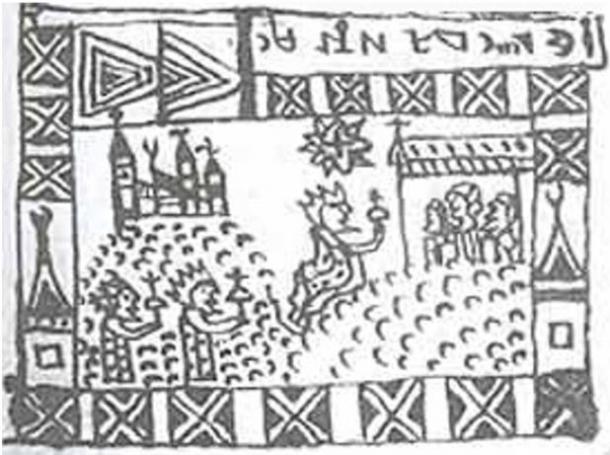 Attila Nyíri of Hungary proposed a solution after studying two pages of the codex. He simply turned the pages upside down, identified a Sumerian ligature, then he associated Latin letters to the rest of the symbols by resemblance. However, he sometimes transliterated the same symbol with different letters, and vice versa, the same letter was decoded from several symbols. Then he even had to rearrange the order of the letters to produce meaningful words. The text, if taken as meaningful, is of religious, perhaps liturgical character. Its beginning: "Eljott az Istened. Szall az Ur. O. Vannak a szent angyalok. Azok. O." – "Your God has come. The Lord flies. Oh. There are the holy angels. Them. Oh." Nyiri's proposition was immediately criticised by Otto Gyurk, pointing to the fact that with such a permissive deciphering method one can get anything out of the code. Also, the mere fact that Nyíri makes an uncritical allusion to the fringe theory that the Hungarian language descended from Sumerian, discredits his enterprise. Daco-Romanian hypothesis A translation has been published by Romanian philologist Viorica Enachiuc. She claims that the text is written in the Vulgar Latin dialect of Dacia, and the direction of writing is right-to-left, bottom-to-top. The alleged translation indicates that the text is an 11-12th century (CE) history of the Blaki (Vlachs) people in their fights against Hungarians and Pechenegs. Toponyms and hydronyms appear as Arad, Dridu, Olbia, Ineu, Rarau, Dniester and Tisa. Diplomatic contacts between Vlad and Alexis Comnenus, Constantine Dukas and Robert of Flanders are also mentioned. 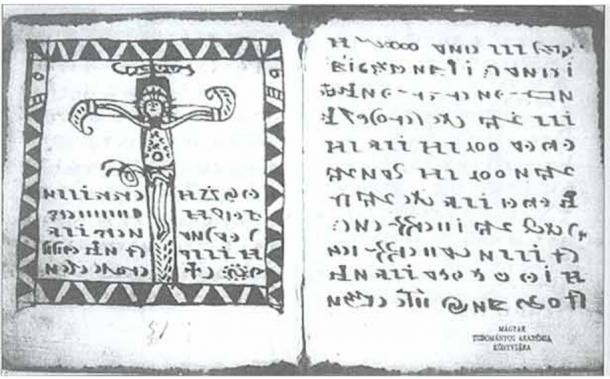 Quotations: "Solrgco zicjra naprzi olto co sesvil cas" – "O Sun of the live let write what span the time" "Deteti lis vivit neglivlu iti iti itia niteren titius suonares imi urast ucen" – "In great numbers, in the fierce battle, without fear go, go as a hero. Break ahead with great noise, to sweep away and defeat the Hungarian!" On one hand, Enachiuc's proposition can be criticized for the method of transliteration. Symbols that characteristically appear in the same context throughout the codex are regularly transliterated with different letters, so that the patterns in the original code are lost in the transliteration. On the other hand, Enachiuc is criticized as a linguist and historian. She provided the only linguistic source of a hitherto unknown state of the Romanian language, and her text (even with her glossary) raises so serious doubts both in its linguistic and historic authenticity that they render her work unscientific. There is no relation between the illustrations of the manuscript (of clear Christian content) and her translation. Brahmi-Hindi hypothesis 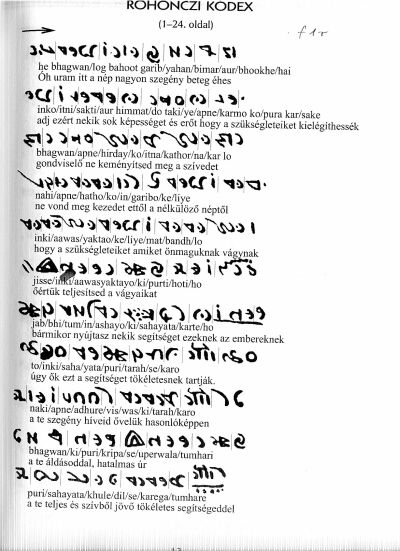
A sample from Mahesh Kumar Singh's attempt Another alleged solution was made by the Indian Mahesh Kumar Singh. He claims that the codex is written left-to-right, top-to-bottom with a so far undocumented variant of the Brahmi script. He transliterated the first 24 pages of the codex to get a Hindi text which was translated to Hungarian. His solution is mostly like the beginning of an apocryphal gospel (previously unknown), with a meditative prologue, then going on to the infancy narrative of Jesus. According to Mahesh Kumar Singh, the upper two rows of page 1 go like: "he bhagwan log bahoot garib yahan bimar aur bhookhe hai / inko itni sakti aur himmat do taki ye apne karmo ko pura kar sake"" – in English: "Oh, my God! Here the people is very poor, ill and starving, therefore give them sufficient potency and power that they may satisfy their needs." Singh's attempt was immediately criticized in the next issue of the same journal. His transliteration completely lacks consistence, and is generally considered a hoax. Systematic attempts Strictly methodical (and successful) investigation of the symbols was first done by Otto Gyurk, who examined repeated sequences to find the direction of writing (he argues for RLTB (Right to Left Top to Bottom), pages also going right-to-left), and identified numbers in the text. His later remarks suggest that he also has many unpublished conjectures, based on a large amount of statistical data. Miklos Locsmandi did some computer-based research on the text in the mid-1990s. He confirmed the published findings of Gyurk, adding several others. Although with no strong arguments, he claimed the symbol "i" to be a sentence delimiter (but also the symbol of 11 (eleven), and possibly also a place value delimiter in numbers). He studied the diacriticals of the symbols (mostly dots), but found no peculiar system in their usage. As he could see no traces of case endings (which are typically characteristic to the Hungarian language), he assumed that the text was probably in a language different from Hungarian. He could not prove that the codex is not a hoax; however, seeing the regularities of the text, he rejected that it be pure gibberish. 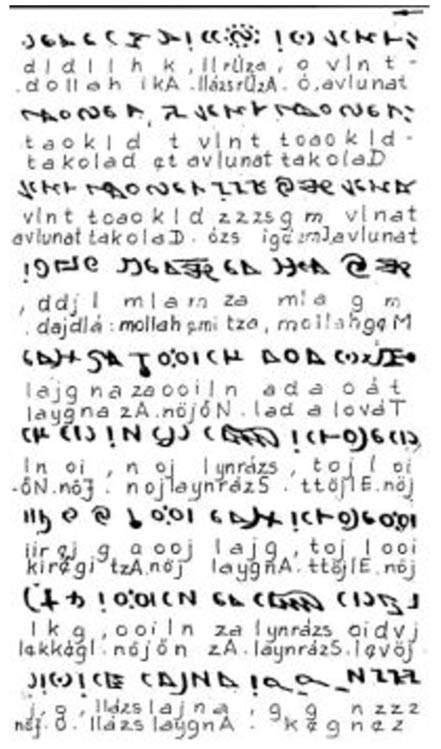 After 2000, research around the codex has become more intense. Benedek Lang summarized the previous attempts and the possible research directions in an article and in a book sized monograph. He argued that the codex is not a hoax (as opposed to mainstream Hungarian academic opinion), instead it is a consciously encoded or enciphered text. It may be (1) a cipher, (2) a shorthand system, or (3) an artificial language. Lang assessed these possibilities systematically in his publications with the help of historical analogies. In 2010 Gabor Tokai published a series of three short articles in the Hungarian popular science weekly, Elet es Tudomany. Tokai tries to date the codex by finding historical analogies of the imagery of the drawings. Although he brings up numerous valuable observations, his conclusions are somewhat vague. Nevertheless his research was the first of its kind. Tokai could not rule out the possibility of a hoax, but he (like Locsmandi) insisted that whatever be the case, the text has regularities that strongly suggest a meaning. Several months later Tokai also published two similarly short articles in which he started to give meaning to specific code chunks. He based his arguments mainly on character strings that appear in pictures (such as the INRI inscription on the cross). His statements are sometimes too hypothetical. However, he claimed to have identified the codes of the four evangelists in biblical references, built up of an evangelist's name and a number, possibly some kind of chapter number. Based on Gyurk's and Locsmandi's work he also showed that many of the four digit numbers in the text are year numbers, using presumably a peculiar Anno Mundi epoch. Simultaneously with, and independently from Tokai, Levente Zoltan Kiraly has made significant progress in describing some structural elements of the code. He demonstrated a method for cutting down the text to sentences with a good probability. He identified a 7 pages long section that is split by numbered headings, with the whole section preceded by its table of contents. Like Tokai, he also discovered the codes of the four evangelists, and in addition he provided a persuasive argument for a "chapter heading system" in the codex that contains biblical references. He also dealt with the overall structure of the codex, showing that the chapter structure is not present the first fourth of the book-partly because that part contains the long, continuous narration of the passion of Jesus Christ. According to Tokai and Kiraly the script is a code system that does not indicate the inner structure of words, and the language of the text is most probably artificial, as optionally proposed by Benedek Lang. They claim that the codex contains the date 1593 CE as a probable reference to its writing. They also state that by character it is an ordinary Catholic reader or breviary of the time, mostly containing paraphrases of New Testament texts (primarily from the Gospels), but also some non-Biblical material, like e.g. Seth returning to the gate of Paradise, or prayers to the Virgin Mary. comments powered by Disqus Submit News/Videos/Links | Discuss article | Article Link | More Unsolved and Unexplained Mysteries |
More can be addded on request. Direct your requests at vinit@theunexplainedmysteries.com
